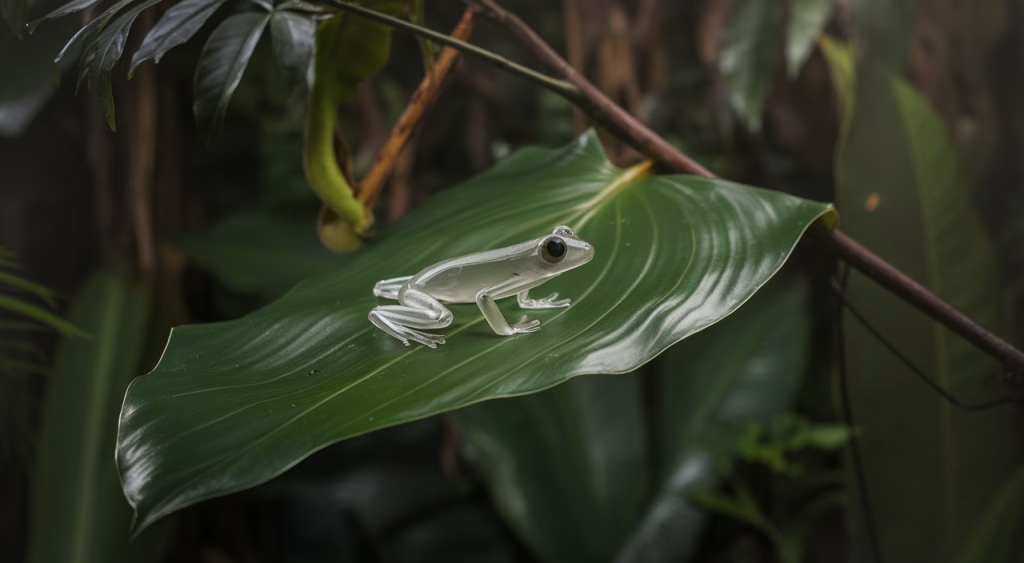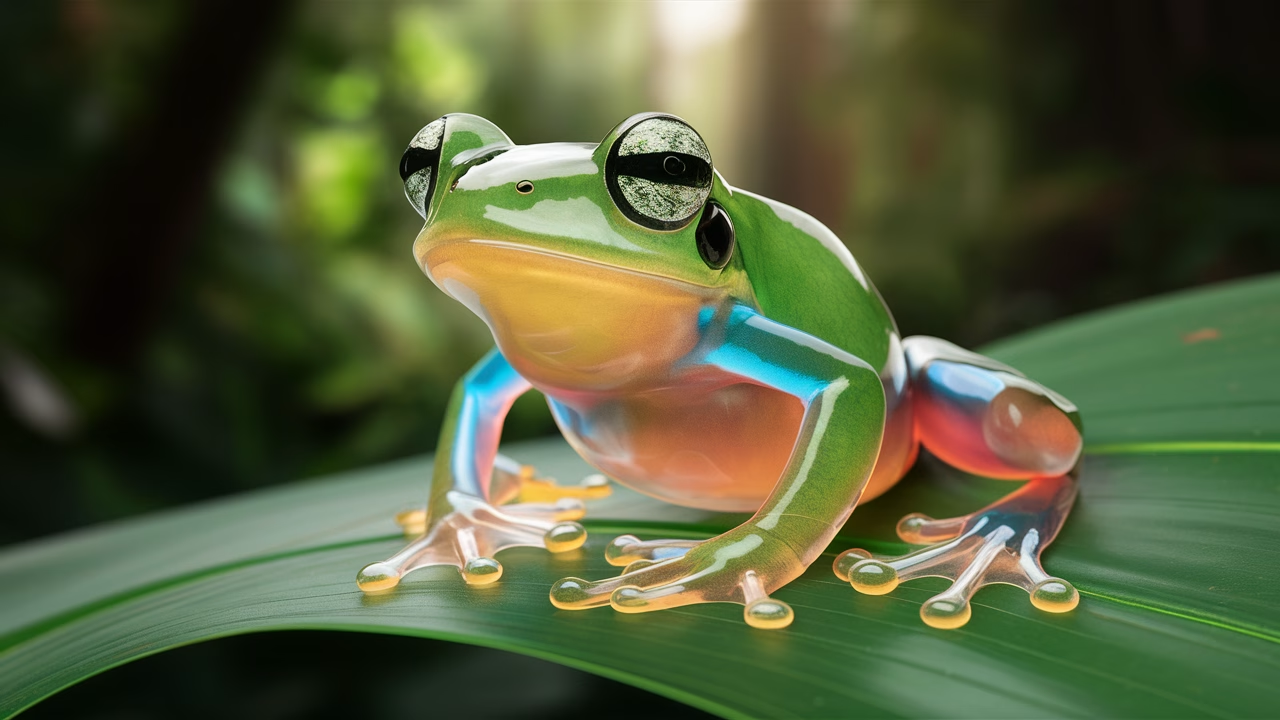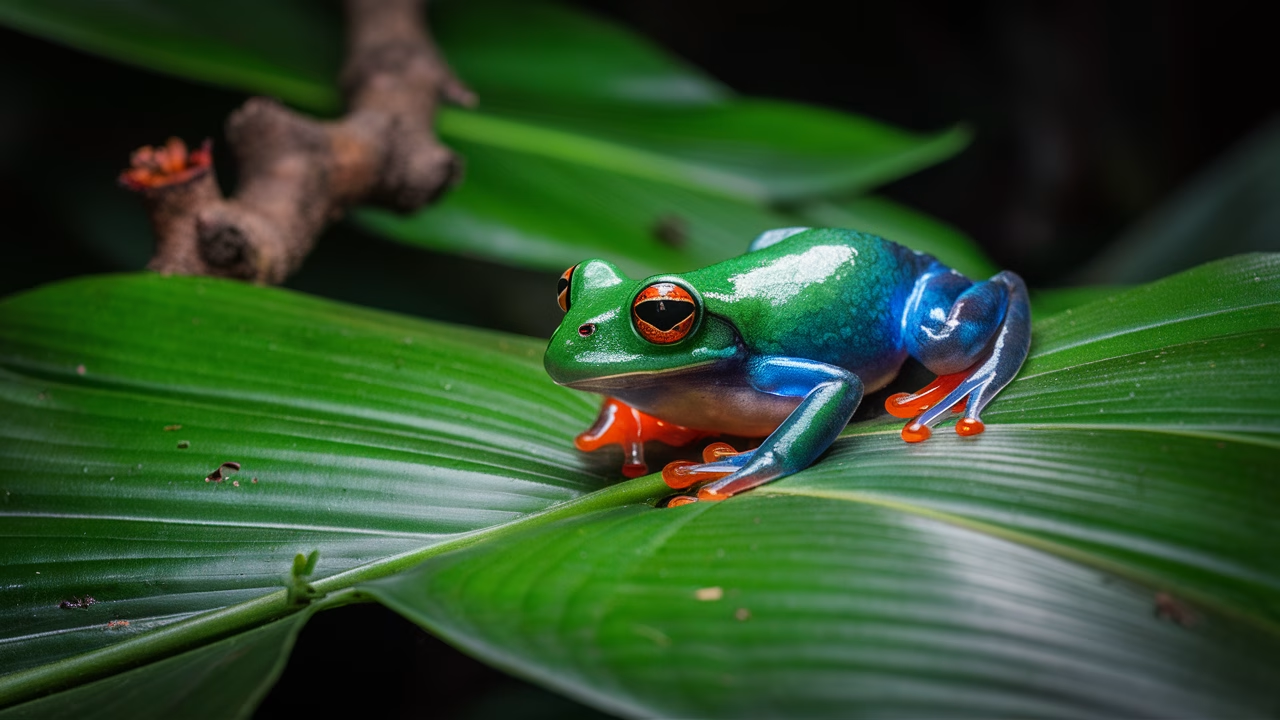How Do Glass Frogs Blend Almost Perfectly into Leaves?
Glass frogs achieve near-invisibility by taking leaf camouflage to the highest level — leveraging transparency to melt into their leafy surroundings. Their translucent skin, particularly on their bellies and limbs, allows the texture and color of leaves to shine right through, creating perfect leaf mimicry.
TL;DR: The Magic of Glass Frogs Transparency
- Key Trait: Glass frogs are known for their translucent bellies — some even reveal internal organs, including the beating heart.
- Main Superpower: Their transparency is a form of biological camouflage, allowing them to blend into green leaves and evade predators.
- Scientific Mechanism: Specialized cellular structures and glass frog transparency mechanisms control light reflection and scattering within their skin.
- Purpose: This form of leaf camouflage reduces shadowing, making glass frogs visually blend into the leaf from multiple angles.
- Conservation: Despite their marvels, many glass frogs species are endangered due to habitat loss and pollution.
Understanding Glass Frogs
Glass frogs are a family of tree-dwelling amphibians, scientifically known as Centrolenidae, native primarily to Central and South America’s humid tropical rainforests. Found on the undersides of leaves above streams, these transparent frogs thrive where light, foliage, and moisture intersect perfectly — the trifecta of thriving glass frog environments.
What pulls scientists and nature lovers alike toward these translucent amphibians isn’t only their ethereal appearance — it’s the scientific puzzle they present. How can something so small practically vanish in daylight using leaf camouflage?
Anatomy and Distinct Features
At first glance, glass frogs may appear similar to other tree frogs. But peer closer, and you’ll notice something extraordinary — their abdominal skin demonstrates remarkable glass frogs transparency, so translucent that you can observe their internal workings in real time. Visible organs like the heart, liver, and gastrointestinal tract invite both wonder and medical curiosity.
Their skin isn’t uniformly see-through. While their undersides show striking transparency, their backs tend to be green, occasionally dotted with small patterns. This selective translucency rather than total invisibility plays a big part in their leaf camouflage strategy.
| Feature | Description |
|---|---|
| Body Length | Typically 1 to 3 inches |
| Habitat | Rainforest canopy, above flowing streams |
| Transparency Zone | Primarily the lower abdomen and legs |
| Diet | Insects and small invertebrates |
| Activity | Nocturnal |
The Science Behind Glass Frog Transparency
Glass frogs don’t merely wear their camouflage — they embody it. Their frog transparency is the product of multiple environmental and cellular adaptations designed to make them nearly vanish where they perch — on the backs of leaves through advanced transparency mechanisms.
Environmental Adaptations
In the dappled light of the rainforest canopy, shadows are predator giveaways. Despite being semi-transparent, glass frogs aren’t entirely invisible. Their real trick lies in minimizing contrast through sophisticated leaf camouflage. By having translucent integument (skin), their bodies don’t cast sharp shadows — instead, they gently “blur” into the leaf’s green surface using transparency mechanisms. It’s almost as if their boundaries dissolve into their surroundings.
Researchers have discovered that glass frogs can control the visibility of their red blood cells through remarkable transparency mechanisms. When they’re sleeping or at rest on leaves, they hide most of their red blood cells in the liver, avoiding interference with light transmission. This temporary “cloaking” system gives these translucent amphibians unmatched leaf camouflage potential.
Cellular Mechanisms
The glass frogs’ skin consists of specialized cells that influence how light interacts with their tissues through complex transparency mechanisms. These include:
- Iridophores: Cells containing reflective platelets that scatter and reflect light through the skin.
- Transparent Collagen: Structural support proteins that allow light to pass through without deviation or distortion.
- Light Scattering Modifiers: Sub-skin layers that reduce the appearance of hard edges and contrast between tissue types.
Ever held a jellyfish up to sunlight? Glass frogs achieve something similar through their transparency mechanisms, but are more structurally complex. And remarkably, their skin maintains elasticity and durability despite its see-through qualities — a feat that even cutting-edge material sciences are still chasing.
Conservation Efforts
As magical as these translucent amphibians may seem, their future hangs precariously in the balance. Due to deforestation, pesticide pollution, and climate change, many species of glass frogs are losing their natural habitat. Adding to the threat is the chytrid fungus — a deadly pathogen decimating amphibian populations worldwide.
Non-invasive research methods, such as infrared imaging, are allowing scientists to study these elusive transparent frogs without affecting their delicate ecosystems. Education, sustainable tourism, and protected environmental zones are among the key efforts being leaned upon.
If you’re keen on helping glass frogs continue their leafy disappearing act for generations to come, supporting rainforest conservation organizations and ethical ecotours can make a real difference for these remarkable translucent amphibians.
Fascinating Facts About Glass Frogs
Because no exploration is complete without a bit of wonder, here are some astonishing facts about these transparent frogs to impress your inner biologist:
- They lay eggs on leaf surfaces: Males protect fertilized eggs from predators and fungal threats until they hatch.
- Some males guard aggressively: Despite their size, glass frogs males can be quite territorial during breeding season.
- Not all are equally translucent: Levels of glass frogs transparency vary greatly among species, with some mostly green and others nearly invisible.
- They communicate through vibrations: Instead of relying solely on croaks, males may use head bobs and vibrations on leaves to stake their claim.
- Skin contains biofluorescent pigments: Under UV light, some glass frogs reflect glowing patterns not visible under regular light.
Final Thoughts
Nature never ceases to amaze — and glass frogs are reminders of its artistic, scientific, and evolutionary brilliance. Their transparency mechanisms aren’t just a visual trick; they represent sophisticated survival strategies built on millions of years of adaptation. For those passionate about biology, their mastery of leaf camouflage offers not just inspiration, but insight into ecosystems and animal behavior.
Next time you imagine a creature going invisible, think less fairy tale — and more tree frog, slowly disappearing into a vibrant green leaf in the heart of a rainforest through remarkable glass frogs transparency.
Frequently Asked Questions
Why do glass frogs go transparent?
Glass frogs become transparent as a defense strategy. Their transparency allows them to blend into green leaves through leaf camouflage, reducing shadows and helping them avoid predators in the rainforest.
Are glass frogs entirely invisible?
No, these transparent frogs are not 100% invisible. Their transparency primarily applies to their bellies and legs, while their backs are typically green. This selective glass frogs transparency makes them hard to detect when viewed from below.
Where can you see glass frogs in the wild?
Glass frogs are found in the rainforest canopies of Central and South America, particularly in countries like Costa Rica, Ecuador, Colombia, and Panama.
What predators do glass frogs have?
Their predators include birds, snakes, and larger insects. Transparency mechanisms reduce the chances of being spotted by these natural enemies.
Can transparency help in other animals too?
Yes, other animals like jellyfish or certain fish also use transparency. However, glass frogs transparency mechanisms for land-based camouflage are especially rare and biologically complex.
How do glass frogs reproduce?
Males guard leaf-laid eggs, typically suspended above moving water so tadpoles can drop into a safe aquatic environment as soon as they hatch.
Are glass frogs endangered?
Many glass frogs species are threatened or endangered due to environmental changes, including deforestation and disease. Conservation efforts are ongoing to protect these translucent amphibians.





